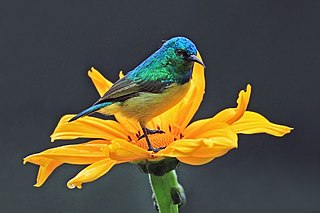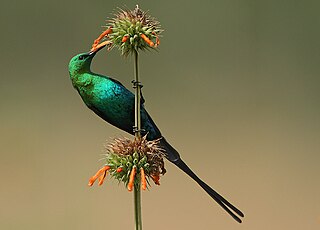See also
- "Sun Bird", a 1908 intermezzo
- Golden Sun Bird, an ancient Chinese artifact
Sunbird may refer to:

Sunbirds and spiderhunters make up the family Nectariniidae of passerine birds. They are small, slender passerines from the Old World, usually with downward-curved bills. Many are brightly coloured, often with iridescent feathers, particularly in the males. Many species also have especially long tail feathers. Their range extends through most of Africa to the Middle East, South Asia, South-east Asia and southern China, to Indonesia, New Guinea and northern Australia. Species diversity is highest in equatorial regions.

The collared sunbird is a bird species of the family Nectariniidae. The sunbirds are a group of very small Old World passerine birds which feed largely on nectar, although they will also take insects, especially when feeding young. The collared sunbird is in fact mainly insectivorous.

The olive-backed sunbird, also known as the yellow-bellied sunbird, is a species of sunbird found from Southern Asia to Australia.

The purple sunbird is a small bird in the sunbird family found mainly in South and Southeast Asia but extending west into parts of the Arabian peninsula. Like other sunbirds they feed mainly on nectar, although they will also take insects, especially when feeding young. They have a fast and direct flight and can take nectar by hovering like a hummingbird but often perch at the base of flowers. The males can appear all black in harsh sunlight but the purple iridescence is visible on closer observation or under good light conditions. Females are olive above and yellowish below.

The purple-rumped sunbird is a sunbird endemic to the Indian Subcontinent. Like other sunbirds, they are small in size, feeding mainly on nectar but sometimes take insects, particularly when feeding young. They can hover for short durations but usually perch to suck nectar from flowers. They build a hanging pouch nest made up of cobwebs, lichens and plant material. Males are brightly coloured but females are olive above and yellow to buff below. Males are easily distinguished from the purple sunbird by the light coloured underside while females can be told apart by their whitish throats.

The crimson-backed sunbird or small sunbird is a sunbird endemic to the Western Ghats of India. Like other sunbirds, they feed mainly on nectar although they take insects, especially to feed their young. They are tiny birds that are resident and are found in forests but are particularly attracted to gardens at the edge of the forest where people grow suitable flower-bearing plants. They usually perch while taking nectar.

Loten's sunbird, also known as the long-billed sunbird or maroon-breasted sunbird, is a sunbird endemic to peninsular India and Sri Lanka. Named after Joan Gideon Loten, who was the Dutch governor of colonial Ceylon, it is very similar to the purple sunbird that is found in the same areas and also tends to hover at flowers for nectar, but can be distinguished by the longer bill, the maroon band on the breast and brownish wings. Like other sunbirds, it is also insectivorous and builds characteristic hanging nests.

The plain-backed sunbird, also known as blue-throated sunbird is a sunbird. The sunbirds are a group of very small Old World passerine birds which feed largely on nectar, although they will also take insects, especially when feeding young. Flight is fast and direct on their short wings. Most species can take nectar by hovering like a hummingbird, but usually perch to feed most of the time.

The malachite sunbird is a small nectarivorous bird found from the highlands of Ethiopia southwards to South Africa. They pollinate many flowering plants, particularly those with long corolla tubes, in the Fynbos.

Aethopyga is a genus of birds in the sunbird family Nectariniidae. Species in this genus are found in South Asia, Southeast Asia and parts of China. Many species such as the grey-hooded sunbird, Apo sunbird, Apo sunbird, Tboli sunbird, metallic-winged sunbird, handsome sunbird and Lina's sunbird are endemic to the Philippines.

Mrs. Gould's sunbird is a sunbird species native to forests and shrublands from the southern foothills of the Himalayas to Southeast Asia.

The green-tailed sunbird or Nepal yellow-backed sunbird is a species of bird in the family Nectariniidae.

The western violet-backed sunbird or Longuemare's sunbird is a species of bird in the family Nectariniidae. It is the most widely ranging species in the violet-backed sunbird superspecies, ranging throughout a large part of tropical mainland sub-Saharan Africa not inhabited by other members of the superspecies. It is mainly found in regions with mesic woodland.
The Amani sunbird is a species of bird in the family Nectariniidae. It is found in Kenya and Tanzania. Its natural habitats are subtropical or tropical moist lowland forests and subtropical or tropical moist montane forests. The male Amani sunbird has a white and dark-green feathered body while the female Amani sunbird has a yellow and grey plumage. Breeding season takes place from May to June and from September to December. The regular diet of the Amani sunbird consists of spiders, caterpillars and other flying insects. It is threatened by habitat loss.

The olive-bellied sunbird is a species of bird in the family Nectariniidae. It is widely spread across African tropical rainforest.

The golden-winged sunbird is a species of bird in the family Nectariniidae. Three subspecies are recognised. It is found in Democratic Republic of the Congo, Kenya, Tanzania, and Uganda.

Cinnyris is a genus of sunbirds. Its members are sometimes included in Nectarinia. They are generally known as double-collared sunbirds because the fringe of their bib usually includes a band of contrastingly coloured feathers.
Loveridge is a surname. Notable people with the surname include:
A. orientalis may refer to:

The Golden Sun Bird is an ancient artifact, unearthed in 2001 from the Jinsha Ruins in Chengdu City, Sichuan Province, China.